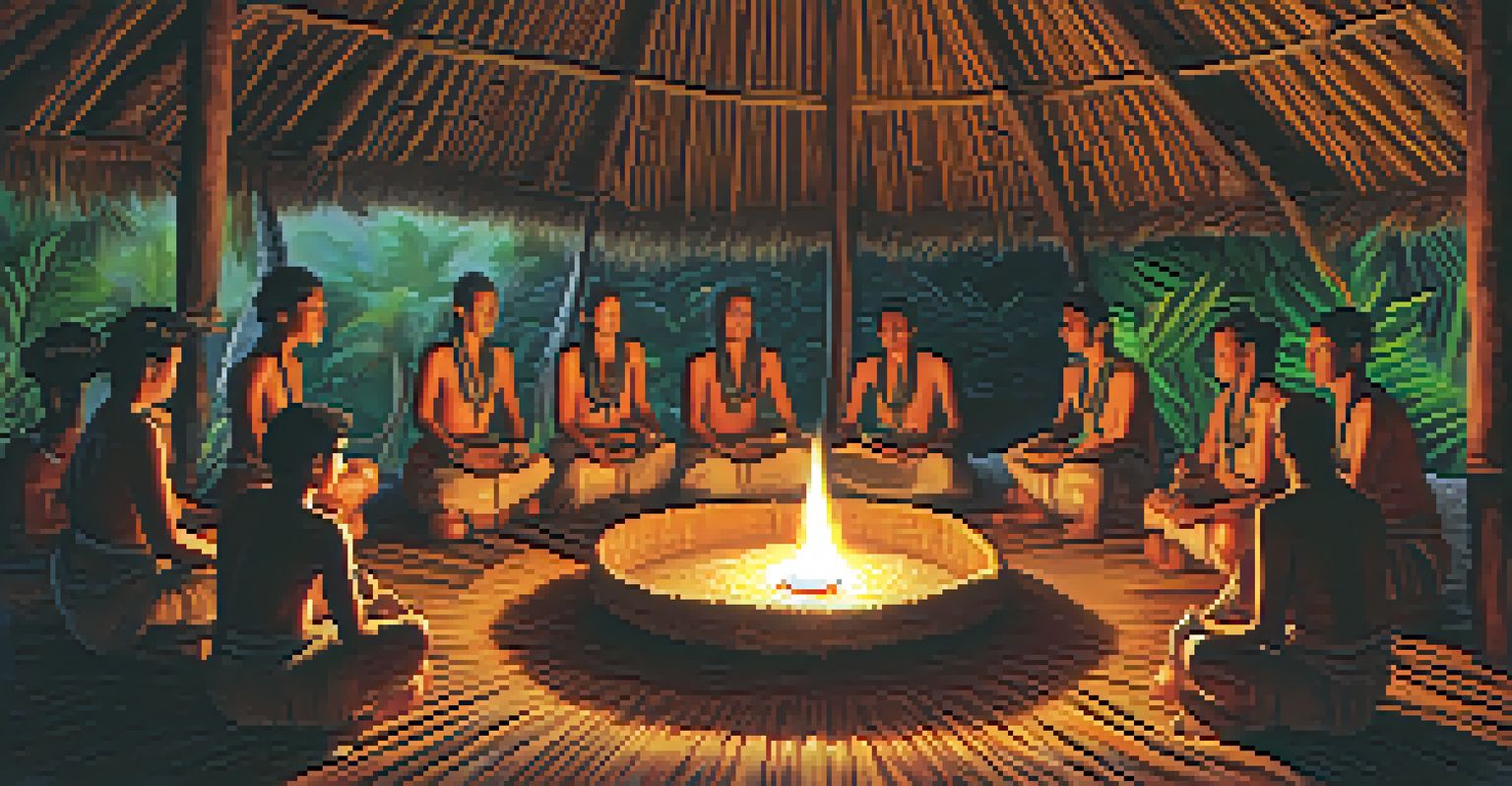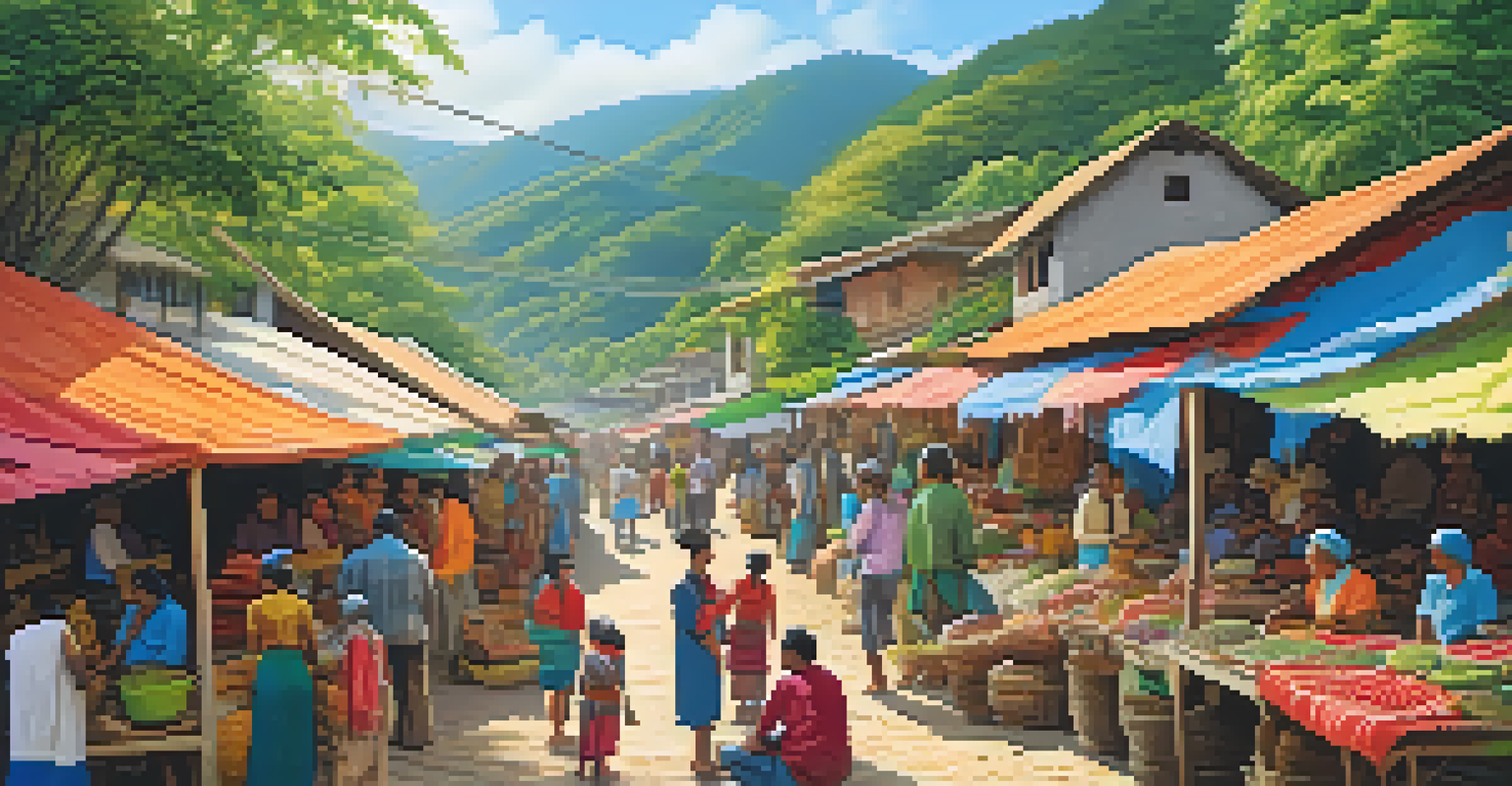Ayahuasca and Community Empowerment Through Tourism

Understanding Ayahuasca: A Journey Within and Beyond
Ayahuasca is a traditional plant medicine from the Amazon, often used in spiritual ceremonies. Its primary ingredient, the Banisteriopsis caapi vine, combined with other plants, creates a powerful brew. Many people seek Ayahuasca to gain insights, heal emotional wounds, or connect with their spiritual selves. This journey is not just personal; it has broader implications for communities involved in its ritualistic practices.
The journey of a thousand miles begins with one step.
The ceremonies are typically led by experienced shamans who guide participants through their experiences. This guidance creates a supportive atmosphere where individuals can explore deep-rooted issues. As awareness of Ayahuasca spreads globally, it draws tourists seeking authentic experiences, thereby increasing interest in indigenous cultures. This influx of visitors has the potential to empower local communities by placing their traditions in the spotlight.
However, it’s essential to approach Ayahuasca tourism with respect for its cultural origins. Communities should be actively involved in how their traditions are shared and commercialized. By ensuring that local voices are heard, the practice can promote cultural preservation while fostering economic empowerment.
The Role of Tourism in Community Development
Tourism can serve as a catalyst for community development, providing necessary resources for local populations. When tourists visit for Ayahuasca ceremonies, they contribute to the economy by staying in local accommodations, dining at community-owned restaurants, and purchasing handmade crafts. This influx of income can lead to improved infrastructure, education, and healthcare within these communities.

Moreover, as communities harness the power of tourism, they can create job opportunities for locals. From shamans and facilitators to hospitality workers, many individuals benefit from the economic boost. This shift can decrease reliance on less sustainable practices, such as logging or mining, which often exploit natural resources and harm the environment.
Ayahuasca's Cultural Significance
Ayahuasca ceremonies offer participants a chance to engage deeply with indigenous traditions, highlighting the importance of respecting cultural origins.
However, it’s crucial for communities to manage tourism sustainably. By establishing guidelines and ensuring that the cultural significance of Ayahuasca remains intact, communities can prevent the commodification of their spiritual practices. This balance is key to ensuring that tourism leads to authentic and meaningful experiences for both visitors and locals.
Empowerment Through Cultural Exchange
Cultural exchange is a powerful aspect of Ayahuasca tourism, allowing visitors to engage with indigenous communities. This interaction fosters mutual respect and understanding, breaking down stereotypes and promoting appreciation for different ways of life. Tourists often leave with a deeper awareness of the challenges these communities face, which can inspire advocacy and support for indigenous rights.
Culture is the widening of the mind and of the spirit.
By sharing their stories, traditions, and practices, local communities can assert their identity in a global context. This empowerment comes from being recognized as custodians of ancient knowledge rather than mere providers of a service. As tourists engage with these cultures, they contribute to a larger narrative that celebrates diversity and resilience.
Moreover, this cultural exchange can lead to partnerships that benefit both tourists and communities. When visitors learn from shamans and participate in ceremonies, they not only gain insights but also become advocates for the community's needs. This collaborative spirit can drive initiatives that prioritize cultural preservation and sustainability.
Challenges of Ayahuasca Tourism
Despite its potential, Ayahuasca tourism comes with significant challenges. One of the primary concerns is the risk of exploitation, where local cultures are commodified for profit. Unscrupulous operators may offer ceremonies without considering the spiritual and cultural significance, leading to a diluted experience for participants and potential harm to the community.
Additionally, an influx of tourists can strain local resources, such as water and food supply. If not managed properly, this can lead to environmental degradation, which undermines the very ecosystems that many Ayahuasca plants depend on. It’s essential for communities to establish limits on tourism to protect both their resources and their cultural practices.
Tourism Benefits Local Communities
Ayahuasca tourism can empower local populations through economic growth, job creation, and improved infrastructure when managed sustainably.
Moreover, the mental health implications for participants cannot be overlooked. While many seek healing, Ayahuasca experiences can be intense and challenging. Communities must ensure that proper support systems are in place, so both visitors and locals can navigate these emotional landscapes safely.
Sustainable Practices in Ayahuasca Tourism
Sustainability is crucial for the long-term success of Ayahuasca tourism. Communities can adopt practices that protect their environment, such as responsible harvesting of plants and promoting eco-friendly accommodations. This approach not only preserves the natural surroundings but also enhances the overall experience for visitors who seek authentic connections with nature.
Education plays a vital role in fostering sustainable tourism. By informing both tourists and local operators about the ecological impact of their activities, communities can encourage responsible behavior. Workshops and informational sessions can empower visitors to engage in practices that support the environment and respect local customs.
Additionally, sustainable tourism can create a cycle of positive reinforcement. As communities thrive from ethical tourism, they can reinvest in their culture and environment. This approach not only benefits the local economy but also ensures that Ayahuasca traditions remain vibrant and respected for future generations.
The Importance of Local Leadership
Local leadership is essential in navigating the complexities of Ayahuasca tourism. Strong community leaders can advocate for fair practices and ensure that tourism benefits the entire community, not just a select few. By fostering a collective approach, they can create a more equitable distribution of resources and opportunities.
These leaders can also serve as cultural ambassadors, sharing their knowledge and traditions with tourists while guiding ethical tourism practices. By establishing standards for ceremonies and tourism experiences, they help maintain the integrity of their cultural heritage. Their involvement ensures that the community’s values are upheld in every interaction.
Sustainability in Ayahuasca Practices
Implementing sustainable tourism practices is essential to preserve both the environment and the cultural integrity of Ayahuasca traditions.
Furthermore, empowering local leaders can inspire younger generations to take an active role in their community. As they witness the benefits of sustainable tourism, they may be motivated to preserve their culture and engage with visitors positively. This cycle of empowerment can create a lasting legacy that honors both tradition and innovation.
The Future of Ayahuasca and Community Empowerment
The future of Ayahuasca tourism hinges on the commitment to community empowerment and sustainable practices. As awareness of Ayahuasca grows, it is vital that communities retain control over how their culture is presented and practiced. By prioritizing local voices, they can shape the narrative and ensure that their traditions are respected.
Innovative approaches, such as eco-tourism and cultural immersion programs, can create new pathways for community engagement. These initiatives allow tourists to connect meaningfully with local cultures while promoting environmental conservation. As communities explore these avenues, they can redefine what Ayahuasca tourism looks like in the 21st century.

Ultimately, the goal should be to create a symbiotic relationship between tourists and communities. By fostering mutual respect and understanding, Ayahuasca tourism can become a powerful tool for empowerment, cultural preservation, and environmental stewardship. This collaborative future holds the promise of enriching lives on both sides of the journey.